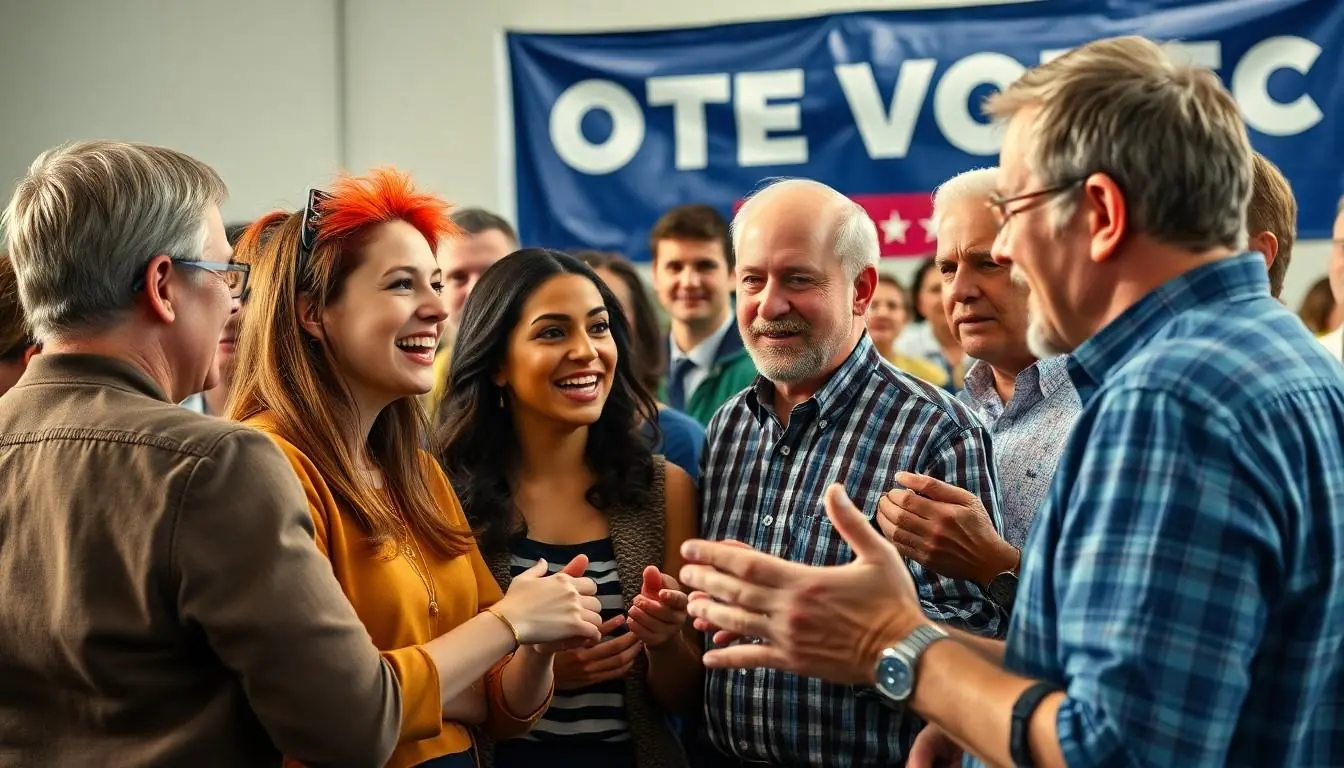Table of Contents
ToggleIn today’s digital age, social media isn’t just for sharing cat videos and vacation selfies; it’s become the secret weapon for political campaigns. Candidates who harness the power of platforms like Twitter, Facebook, and Instagram can reach millions faster than you can say “vote for me!” With the right strategy, they can engage voters, share their message, and even create viral moments that leave traditional campaigning in the dust.
Imagine a candidate tweeting their way into the hearts of voters while simultaneously dodging awkward questions like a pro. It’s a wild world out there, and social media is the playground. The ability to connect directly with constituents, respond in real-time, and showcase authenticity can make or break a campaign. Buckle up as we explore how social media is reshaping the political landscape and why every campaign needs to get in the game.
Overview of Social Media for Political Campaigns
Social media serves as a crucial tool in today’s political campaigns. Candidates leverage platforms such as Twitter, Facebook, and Instagram to disseminate messages effectively. These channels facilitate direct interaction with voters, fostering a sense of connection and accessibility.
Strategies focused on content creation support the amplification of campaign messages. Engaging visuals, targeted ads, and shareable posts enhance outreach efforts. Viral moments generated on social media can significantly shape a candidate’s public perception, making it vital to approach these platforms with intent and creativity.
Authenticity matters for constituents. Campaigns that showcase genuine interactions gain trust and deeper engagement from potential voters. Candidates often utilize live streaming and behind-the-scenes content to cultivate a relatable image.
Analyzing data from social media activity provides insights into voter behavior. Campaigns track metrics such as engagement rates, follower growth, and post reach to gauge effectiveness. Adjusting strategies based on these analytics ensures that campaigns maximize their social media presence.
Moreover, social media influences the narrative surrounding political issues. Candidates can quickly respond to current events or misinformation, controlling the conversation. This reactive capability enhances a campaign’s adaptability in an ever-changing political landscape.
Utilizing social media effectively involves a blend of strategy and innovation. By understanding their audience and using analytics, candidates can tailor their messages to resonate deeply. Overall, the evolving dynamic of social media significantly impacts political campaign strategies and voter engagement.
Benefits of Social Media in Political Campaigns


Social media provides unique advantages for political campaigns by facilitating real-time interaction and outreach to voters. Candidates leverage these platforms to enhance engagement and foster community connections. To effectively cut through the noise and reach a wider demographic, campaigns strategically focus on increasing their content’s visibility on specific platforms like TikTok. This can sometimes involve exploring services that help purchase TikTok views from SocialBoosting to give critical messages a rapid initial boost in reach and perceived traction.
Increased Voter Engagement
Increased voter engagement results from direct conversations between candidates and constituents. Candidates use posts, comments, and polls to encourage participation. Real-time feedback promotes a sense of inclusion among voters. Sharing compelling stories and visuals captures attention and drives discussions, elevating important issues. Authentic content resonates with audiences, fostering trust. Campaigns that prioritize engagement see higher voter turnout and support.
Cost-Effective Marketing Strategies
Cost-effective marketing strategies often drive political campaigns. Digital advertising on social media platforms offers targeted reach at lower costs compared to traditional methods. Campaigns can allocate budget effectively by selecting specific demographics, interest groups, and geographic locations. Measuring performance through analytics enables optimization of spending and strategy adjustments. Engaging content spreads organically, further amplifying reach without additional costs. This approach allows candidates to maintain financial efficiency while maximizing visibility and impact.
Challenges of Using Social Media for Political Campaigns
Social media presents specific challenges for political campaigns, impacting strategies and outcomes.
Misinformation and Fake News
Misinformation spreads rapidly across social media platforms. False narratives can distort public perception and influence voter opinions. In 2020, around 70% of US adults reported encountering false information online, highlighting the urgency for campaigns to combat misinformation actively. Fact-checking and transparent communication serve as vital tools for addressing fake news. Candidates must adopt proactive measures to ensure accurate messaging. Consequently, misinformation not only harms credibility but also undermines the democratic process.
Audience Polarization
Audience polarization poses a significant hurdle in social media campaigning. Social media algorithms often amplify content that resonates with existing beliefs, creating echo chambers. Studies show that users are more likely to engage with political content that aligns with their views, leading to increased division among voters. Campaigns struggle to reach diverse audiences and communicate effectively across differing perspectives. To address polarization, candidates must craft inclusive messages that resonate with a broad spectrum of constituents. Emphasizing shared values can help bridge divides and foster dialogue among supporters.
Effective Strategies for Utilizing Social Media
Social media provides powerful tools for political campaigns. By implementing effective strategies, candidates can maximize their reach and impact.
Content Creation and Distribution
Engaging content serves as the backbone of a successful social media campaign. Candidates focus on creating compelling visuals and shareable videos that capture attention. Authentic storytelling builds emotional connections with voters. Regular posting keeps the content fresh and relevant. Additionally, sharing behind-the-scenes glimpses fosters relatability and transparency. Campaigns should utilize various formats like live streams and polls to encourage interaction. By effectively distributing content across platforms, candidates increase visibility and enhance their chances of going viral.
Targeted Advertising Techniques
Utilizing targeted advertising techniques allows campaigns to reach specific demographics. Identify key voter segments and tailor messages that resonate with those groups. Social media platforms offer advanced targeting options based on user behavior, interests, and location. Crafting distinct ads for different audiences enhances engagement. A/B testing helps determine which messages perform best. Moreover, allocating budget efficiently based on data analytics maximizes ad effectiveness. Candidates should remain agile, adjusting strategies as needed based on real-time performance metrics. This focused approach ensures that campaigns effectively connect with potential supporters and drive voter turnout.
Case Studies of Successful Campaigns
Barack Obama’s 2008 campaign revolutionized social media use in politics. His team utilized platforms like Facebook and Twitter to connect with young voters, raising over $500 million online from small donations. Emphasizing grassroots engagement, he encouraged supporters to share their stories, creating a sense of community.
In 2016, Donald Trump effectively employed Twitter to communicate directly with supporters. His frequent posts generated real-time engagement, often leading to viral moments. This strategy allowed him to bypass traditional media channels and shape narrative directly, reaching approximately 13 million followers by Election Day.
More recently, Alexandria Ocasio-Cortez’s campaign in 2018 showcased the impact of live streaming. Utilizing Instagram Live, she connected with followers in a personal way, discussing campaign issues and sharing behind-the-scenes content. Her use of social media propelled her to victory in a primary election against a long-time incumbent.
Additionally, the 2020 Biden campaign adopted a multi-platform approach to maximize outreach. They effectively combined targeted ads on Facebook with engaging TikTok videos aimed at younger voters. This strategy resulted in increased voter engagement among demographics that typically have lower turnout rates.
Campaigns can also learn from these examples when crafting public messaging. Authenticity remains crucial, as seen with Ocasio-Cortez’s relatable posts and Obama’s calls for community stories. Engaging visuals and shareable content have proven effective tools for connecting with diverse voter groups.
Furthermore, data-driven strategies played a vital role in each of these campaigns. By analyzing voter engagement metrics, teams adapted their messaging to resonate more effectively. Regular performance assessments enabled campaigns to refine strategies, ensuring they remained relevant throughout election cycles.




